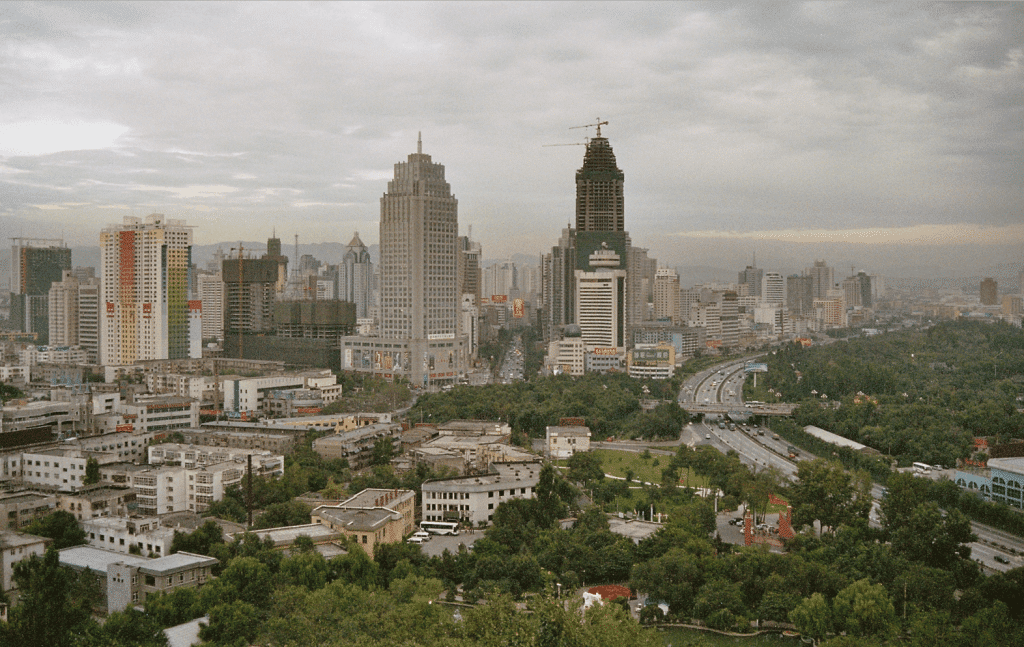China’s high-tech surveillance drives oppression of Uyghurs
By Steven Feldstein | October 27, 2022
 The Chinese city of Urumqi in Xinjiang. Credit: Alexander Flühmann via Wikimedia Commons. CC BY-SA 3.0.
The Chinese city of Urumqi in Xinjiang. Credit: Alexander Flühmann via Wikimedia Commons. CC BY-SA 3.0.
On August 31, 2022, in the final hours of UN High Commissioner for Human Rights Michelle Bachelet’s term, after months of delays and postponements, her department released a comprehensive report detailing China’s oppression in Xinjiang Province. The circumstances of China’s repression are well documented. Academics and human rights organizations estimate that 10 to 20 percent (with an upper limit calculated at 1.8 million) of adult Uyghurs in Xinjiang have been subjected to detention by Chinese authorities. Officials in that country have established a network of 1,300 to 1,400 “vocational education and training centres,” to enforce a mass incarceration campaign. The facility structuresincorporate security features, such as “high walls, watch towers, and barbed-wired external and internal fencing.” Uyghur detainees describe systematic use of torture, mistreatment, mass rape, and forced sterilization as a condition of incarceration. (Forced sterilization has allegedly occurred among the general Uyghur population as well.) While the UN report pointedly refrains from calling out China’s actions as genocide, it recognizes that these allegations “may constitute international crimes, in particular crimes against humanity.”
Underpinning China’s system of oppression is a high-tech network of surveillance. Developed in partnership with private companies, China has unleashed wholesale monitoring and tracking of Uyghur individuals, including biometric data collection of facial imagery and iris scans and genomic surveillance through mandatory DNA sampling. According to the UN report: “Such monitoring has reportedly been driven by an ever-present network of surveillance cameras, including facial recognition capabilities; a vast network of “convenience police stations” and other checkpoints; and broad access to people’s personal communication devices and financial histories, coupled with analytical use of big data technologies.”
What can be concluded about Xinjiang? Have Chinese authorities established a new model for digital control? While a fair case can be made that China’s approach is gaining influence in certain countries—mostly authoritarian states—it’s unlikely to lead to full-scale adoption of China’s techno-repression model for the simple fact that few countries possess the resources or digital know-how to implement these systems.
China has invested immense resources in its domestic security capabilities. Researcher Adrian Zenz estimates that 2017 domestic security spending in Xinjiang alone is around $8 billion, a tenfold increase from expenditures in 2007 of $700 million. Zenz assesses that overall Chinese internal security outlays in 2017 totaled $197 billion. (When calculated on a purchasing power parity basis, this is equivalent to $349 billion, double the United States’ estimated spending of $165 billion.) Unsurprisingly, Chinese cities are the most surveilled in the world, featuring more CCTV cameras per square mile than any other country. Many of these cameras are equipped with advanced features, including facial recognition technology (FRT) and computing analytics.
No other country comes close to matching China’s domestic security expenditures along with its investments in advanced technology. Some experts, for example, make comparisons to Russia. Andrei Soldatov and Irina Borogan, both non-resident senior fellows with the Center for European Policy Analysis, describe the emergence of a “new iron curtain” featuring a push by Russian authorities to institute full control over the country’s internet and block citizens from accessing independent news sources or foreign platforms. These are concerning trends, yet they significantly lag measures already instituted in China.
Russia, in fact, has encountered considerable difficulties shifting course. Leonid Kovachich, a Moscow-based China watcher, and Andrei Kolesnikov, a senior fellow at the Carnegie Endowment for International Peace, observe that unlike in China, Russia’s internet infrastructure “was originally built according to Western principles of openness.” Russia’s adoption of the same firewalls and content monitoring used by China has been difficult to achieve because the underlying internet architecture relied upon by Moscow is not well suited to authoritarian control. When it comes to physical surveillance devices, such as facial recognition cameras, Moscow also is playing catch up. It was just in 2021 that Moscow rolled out a mass-scale facial recognition payment system for its metro. And it was only more recently, in the context of anti-war protests in 2022, that Russian authorities have begun to fully tilt these technologies towards repressive ends.
China’s mass surveillance program, by comparison, dates back to the early 2000s. As I wrote in The Rise of Digital Repression, the Chinese government first launched its SKYNET program in 2005, which was intended to blanket the country’s roads, districts, schools, and businesses with public surveillance devices. By 2017, this network had grown to include 170 million cameras. In subsequent years, China also launched a safe cities program, designed to keep a close watch on urban areas (funded with $140 billion of investment), and initiated the Sharp Eyes program, intended to supplement the SKYNET and safe cities programs by combining public surveillance networks with private networks guarding homes and private businesses. The end goal is to provide seamless monitoring for all of the country’s 1.4 billion people. Simply put, no other state rivals the surveillance capabilities built up by the Chinese Communist Party in the last decades.
But even if China’s efforts are singular in their scale and sophistication, this does not mean its actions won’t have sway. One of the biggest risks stemming from China’s surveillance machinery is its demonstration effect—illustrating to other governments the possibilities of techno-repression. Just because certain countries do not have the resources to emulate China’s system of control does not mean that their leaders will not seek China’s help in implementing specific repressive objectives. Empirically, countries from Uganda to Myanmar have purchased Chinese surveillance equipment to support their repressive agendas, whether suppressing opposition politicians ahead of national elections via a safe city system or installing facial recognition technology to counteract opposition forces.
In general, China exerts its digital influence in three significant ways:
- Sway the technical adoption of digital standards in favor of Chinese infrastructure and platforms. These standards often emerge from standard-setting organizations, such as the International Telecommunication Union, the International Organization for Standardization, or the Institute of Electrical and Electronics Engineers and address everything from the handling of, and protocols for, data transmission or specifications for interoperability. China’s drive to redesign internet infrastructure under the “new IP” (internet protocol) framework, which would embed a system of centralized rule enforcement and give states an unprecedented ability to censor content, is a classic example of the Asian country’s push to use digital infrastructure to advance its core foreign policy objectives.
- Shape global norms to make it more acceptable for countries to implement censorship and surveillance networks, such as providing “parallel modeling” that demonstrates to other states the benefits of digital repression strategies. While other countries cannot match China’s mass surveillance networks, Beijing’s efforts offer potent ideas for how authoritarian leaders can monitor and control their citizens more effectively.
- Increase commercial adoption of Chinese infrastructure and platforms—from ICT networks to 5G wireless technology—through the Digital Silk Road and Belt and Road Initiative. These efforts not only advance China’s economic interests, but as Matthew Erie, an associate professor of modern Chinese studies at the University of Oxford, and Thomas Streinz, executive director of Guarini Global Law & Tech at New York University School of Law, describe in the The Beijing Effect, they help shape “the conditions under which these countries transition towards digitally-mediated economies and societies.” In other words, countries that build out their ICT infrastructure using Chinese equipment will be more inclined to adopt Chinese standards and products to meet future needs.
In this light, the UN’s report on Xinjiang is particularly damaging to China when it comes to the second item—Beijing’s bid to reshape global norms. While the UN has its critics, it remains a venue that China takes seriously and an important arbiter of norms and behavior. Chinese diplomats spent months fighting the report’s release. When the report came out, senior officials lashed out against its findings, claiming that “its purpose definitely is to undermine China’s stability and obstruct China’s development.” A subsequent resolution in the UN Human Rights Council to hold debate on abuses in Xinjiang failed on a 19 to 17 vote (with 11 abstentions) due to furious lobbying by the Chinese delegation. While the vote failure is a setback for efforts to hold China accountable for its abuses, the larger global disapproval of China’s techno-repressive agenda should not be underestimated.
Xinjiang has become a symbol of the omnipotence of the state and the belief by certain governments that they can use whatever means necessary to subjugate their citizens. Xinjiang stands as a warning about what the road to impunity looks like. But it is also important not to be overly deterministic about the role of technology in fostering repression—whether in Xinjiang or elsewhere. The overriding motivation guiding China’s policies in the region is a commitment to crushing dissent in the Uyghur community. Technology is a function of this underlying system of oppression geared to cement China’s control of the region. Even if China lacked access to artificial intelligence technology or facial recognition cameras, there is little doubt its security forces would find alternate means to subdue citizens in the region.
Together, we make the world safer.
The Bulletin elevates expert voices above the noise. But as an independent nonprofit organization, our operations depend on the support of readers like you. Help us continue to deliver quality journalism that holds leaders accountable. Your support of our work at any level is important. In return, we promise our coverage will be understandable, influential, vigilant, solution-oriented, and fair-minded. Together we can make a difference.
Keywords: China, Facial Recognition, Uyghurs, surveillance
Topics: Disruptive Technologies














